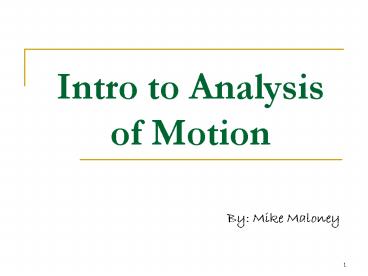Intro to Analysis of Motion - PowerPoint PPT Presentation
1 / 12
Title:
Intro to Analysis of Motion
Description:
Intro to Analysis of Motion By: ... it is describing how a s#!t load of stuff moves in as many ways as possible so we can ... * Beyond Velocity So now we know ... – PowerPoint PPT presentation
Number of Views:135
Avg rating:3.0/5.0
Title: Intro to Analysis of Motion
1
Intro to Analysis of Motion
- By Mike Maloney
2
What is Kinematics?
Or in normal human words, it is describing how a
s!t load of stuff moves in as many ways as
possible so we can understand the world better.
- Kinematics is the science of describing the
motion of objects using words, diagrams, numbers,
graphs, and equations. The goal of any study of
kinematics is to develop sophisticated mental
models which serve to describe (and ultimately,
explain) the motion of real-world objects.
3
How can we describe Motion?
- Lets say Homer is sitting on my desk. Everyone
but you closes their eyes and when they open them
Homer is now on a different desk. - How could you describe to the rest of the class
the motion of Homer you observed? - What terms could you use?
- What different ways could you describe it?
- Lets use InterLace to discuss it.
4
Distance vs. Displacement
- We usually call the movement of an object its
distance traveled. - In the physics world, we have two words that
describe the amount of movement of an object - Distance
- Displacement
- We will learn how they are different next
chapter. - For now, we will use displacement, which is your
change in position. - Now lets try to describe Homers motion.
5
Displacement (change in position)
- Lets call your position s.
- How might you write change in position?
- Hint think to chemistry or lines in math class?
- We can use delta (?), which means change
- Displacement (change in position) is written as
?s - How can you change your position?
- Go forward
- Go backward
- Go Sideways, or up, or down,
- How can we tell the difference?
6
Displacement (?x)
- That is what and is for.
- ?s means you have moved in the positive
direction. - - ?s means you have moved in the opposite
direction.
SPECIAL NOTE In real life what you call forward
or backward or positive or negative direction is
completely arbitrary. As long as you are
consistent, and forward is opposite backward, and
positive is opposite negative direction it does
not matter.
7
Velocity (v)
- Another way to describe motion is to combine
displacement and time. - If we use time to determine how fast an object
can change position, and fine the time rate of
change in position, we get something called speed
or more accurately velocity. - Rate is something that comes up again and again
in physics. So what does it mean? - It is just how much something changes something
else does. For example - How much money you earn per week
- How many shots you make per game
- How many times I roll my eyes per class
8
Velocity (v)
- Since you can move forward or backward, we need
a way to describe this in terms of velocity. Any
ideas? - Right, we use and again.
- velocity (v) means you are moving in whatever
you called the positive direction, or you have a
positive change in position over time. - - velocity (-v) means you are moving in the
negative direction or you have a negative change
in position over time.
9
Beyond Velocity
- So now we know that position can change
(displacement) and the time rate at which it
changes is called velocity. - Is this enough to completely describe Homer?
- Velocity is not always constant.
- When you step on the gas pedal in a car the car
speeds up, the velocity increases. - Stepping on the brake does the opposite, the
velocity decreases, the car slows down. - So we need a way to describe this too.
10
Acceleration (a)
- Just as velocity is the time rate of change of
displacement, acceleration a is the time rate
of change of velocity. - Acceleration can be positive or negative -.
- A positive acceleration means increasing
velocity - A negative - means decreasing velocity
- Hmmm. Is there any other way we could get a
acceleration? - Ahh! It is a little tricky, but we could also use
a decreasing () velocity. Anyone know how or
why?
11
How can we diagram motion
- Now that we know some terms that describe motion,
how can we diagram it or graphically describe it? - Motion Diagrams (Interlace Java)
- Graphs (with Usain Bolt)
- Graphing Challenge (doc game)
12
The 4 ways to describe Motion
Motion Diagrams
Words
Variables and Equations
Graphs































